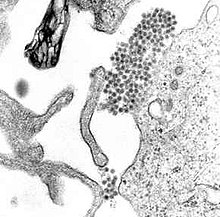Dengue virus
| Dengue virus | |
|---|---|
 |
|
| A TEM micrograph showing dengue virus virions (the cluster of dark dots near the center). | |
| Virus classification | |
| Group: | Group IV ((+)ssRNA) |
| Order: | Unassigned |
| Family: | Flaviviridae |
| Genus: | Flavivirus |
| Species: | Dengue virus |
Dengue virus (DENV) is the cause of dengue fever. It is a mosquito-borne single positive-stranded RNA virus of the family Flaviviridae; genus Flavivirus. Five serotypes of the virus have been found, all of which can cause the full spectrum of disease. Nevertheless, scientists are finding their understanding of dengue virus may be simplistic, as rather than distinct antigenic groups there appears to be a continuum. This same study identified 47 strains of dengue virus. Additionally, coinfection with and lack of rapid tests for zika virus and chikungunya complicate matters in real world infections.
Its genome is about 11000 bases of positive-sense single stranded RNA (ssRNA) that codes for three structural proteins (capsid protein C, membrane protein M, envelope protein E) and seven nonstructural proteins (NS1, NS2a, NS2b, NS3, NS4a, NS4b, NS5). It also includes short non-coding regions on both the 5' and 3' ends.
The dengue type 1 virus appears to have evolved in the early 19th century. Based on the analysis of the envelope protein there are at least four genotypes (1 to 4). In 2013 a fifth serotype was reported. The rate of nucleotide substitution for this virus has been estimated to be 6.5×10−4 per nucleotide per year, a rate similar to other RNA viruses. The American African genotype has been estimated to have evolved between 1907 and 1949. This period includes World Wars I and II, which were associated with considerable movement of populations and environmental disturbance, factors known to promote the evolution of new vector-borne viral species.
...
Wikipedia
